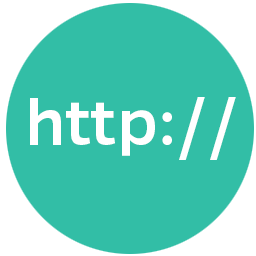Connect Salesforce® Marketing Cloud to HTTP Request (GET/POST) with LeadsBridge


In this article, you'll learn how to set up the bridge and connect Salesforce® Marketing Cloud to My CRM Example using LeadsBridge.
How to set up your bridge step-by-step tutorial
Before you start
- Head over to the left sidebar and click on the Create new Bridge green button
- You'll be taken to the first step of the bridge creation
Step 1: Choose the apps you want to connect
- Choose Salesforce® Marketing Cloud as the source for your bridge
- Choose HTTP Request (GET/POST) as the destination for your bridge
- Click on the Continue button
- At this point you can choose a name for your bridge (this will only be visible inside LeadsBridge and you can also edit it later)
Step 2: Configure your Salesforce® Marketing Cloud with HTTP Request (GET/POST)
Step 2.A: Setup your Salesforce® Marketing Cloud integration
- Click on Connect Salesforce® Marketing Cloud
- Click on Create new integration to connect your Salesforce® Marketing Cloud (or select an existing one from the dropdown if you already connected it)
- A popup wil be opened where you can authorize the Salesforce® Marketing Cloud integration
- Fill Client ID, Client Secret, Authentication Base URI field to connect Salesforce® Marketing Cloud with LeadsBridge
- Click on the Authorize button
- You can choose a name for this Salesforce® Marketing Cloud and LeadsBridge integration (you can also edit it later)
- Once done, click on Continue button and you will get back to the bridge experience where you could choose additional integration settings
- Now that your Salesforce® Marketing Cloud is connected, you can continue with the set-up of your bridge
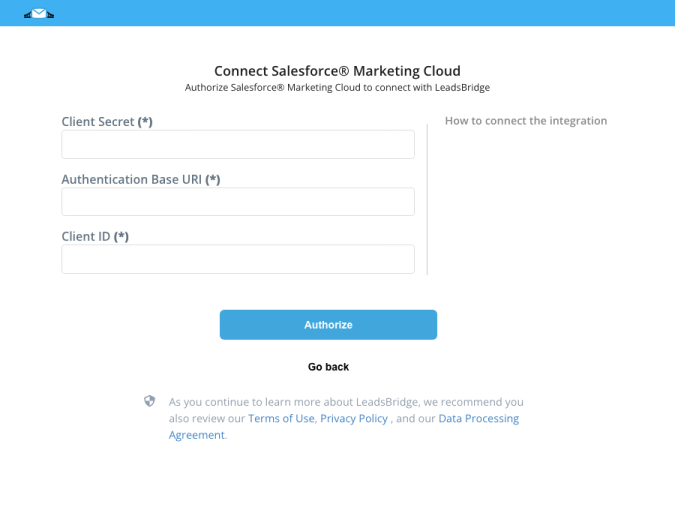

Step 2.B: Configuration details for Salesforce® Marketing Cloud
How to get Client ID, Client Secret, Authentication Base URI
- Log into Exact Target with an Admin User
- On the top right of the screen, next to your username, make sure to select the correct Company, or Business Unit, that you want to connect with LeadsBridge
![]()

- Click on your username on the top right of the screen
- Click on Setup
- Go to Apps » Installed Packages, under Platform Tools
- Click on New at the top right of the screen
![]()

- Give a name to your New Package, for example LeadsBridge
- Click on Save
![]()

- Click on Add Component
![]()

- Select API Integration, then click on Next
![]()

- Select Server-to-Server, then click on Next
![]()

- Click on the Edit button of the API Integration you just created
![]()

- Flag the following items:
- Under Channels » Web, flag Read, Write and Publish
![]()

- Under Contacts » Audiences & Contacts » List and Subscribers, flag every item (if you want to use Lists)
![]()

- Under Data » Data Extensions & Data » File Locations, flag every item (if you want to use Data Extensions )
![]()

- Click on Save
- Copy the Authentication Base URI, Client ID and Client Secret from the API Integration you have just created on Exact Target
![]()

- Paste that information inside your LeadsBridge integration setup
Step 2.C: Setup your HTTP Request (GET/POST) integration
- Click on Connect HTTP Request (GET/POST)
- Click on Create new integration to connect your HTTP Request (GET/POST) (or select an existing one from the dropdown if you already connected it)
- A popup wil be opened where you can authorize the HTTP Request (GET/POST) integration
- Fill URL field to connect HTTP Request (GET/POST) with LeadsBridge
- Click on the Authorize button
- You can choose a name for this HTTP Request (GET/POST) and LeadsBridge integration (you can also edit it later)
- Once done, click on Continue button and you will get back to the bridge experience where you could choose additional integration settings
- Now that your HTTP Request (GET/POST) is connected, you can continue with the set-up of your bridge
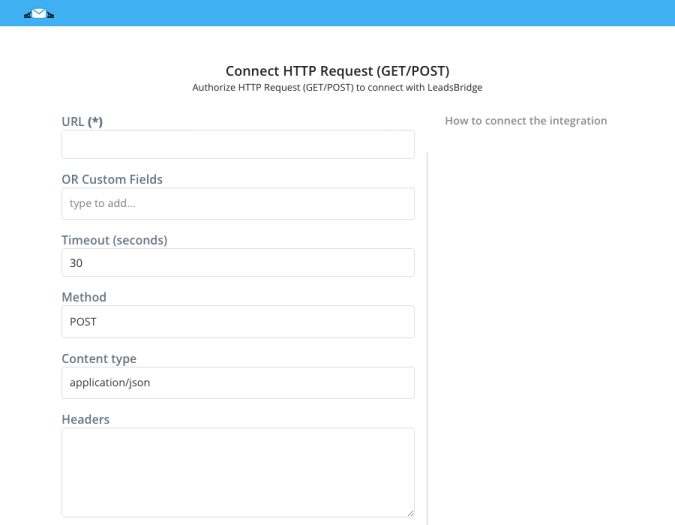

Step 2.D: Configuration details for HTTP Request (GET/POST)
How to get URL
- URL - mandatory: where the system you'd like to send information to is located.
- Method - mandatory: the request method your system may receive as the indication of the desired action to be performed.
POSTis the default value. It's used to send data to a server to create/update a resource and it's one of the most common HTTP methods. If you're unsure about what you should select, leave it as is.
- Content Type - mandatory: is used to indicate the media type of the resource. Works as the content type description for the message body.
application/x-www-form-urlencodedis the most common encoding type. Use this as long as you're not using any JSON or XML language on the request body.
- Success pattern - optional: the message your system replies with once the request was received successfully.
- Failure pattern - optional: an error message your system sends when there's an issue with the request.
- Skip encoding parameters in URL - optional: if enabled prevent the encoding of special characters in the URL parameters
Other Info
- Body - mandatory: the message Body is where all the data is set to eventually form the HTTP Request that will be sent to insert each lead into your system.
- Body syntax should be write as follows:[code]"field_id": "value″[/code]"field_id" is the unique identifier of the field inside your CRM/platform; "value" can be static (number or text that will be the same for every lead synced) or dynamic.
- To create dynamic values just enter the field name between the double
@@symbols, that will results in a @@field_name@@ syntax. The field name can be whatever you'd like, it will help you recognize the field inside the bridge settings later.
Dynamic fields will be displayed on the Fields Matching step of the bridge, where you will be able to match them with lead's information. - That said, if we have a full_name field on our platform to store the lead's full name, we should use the following syntax:
[code]full_name: @@FullName@@[/code]Please check HTTP common questions for code examples.
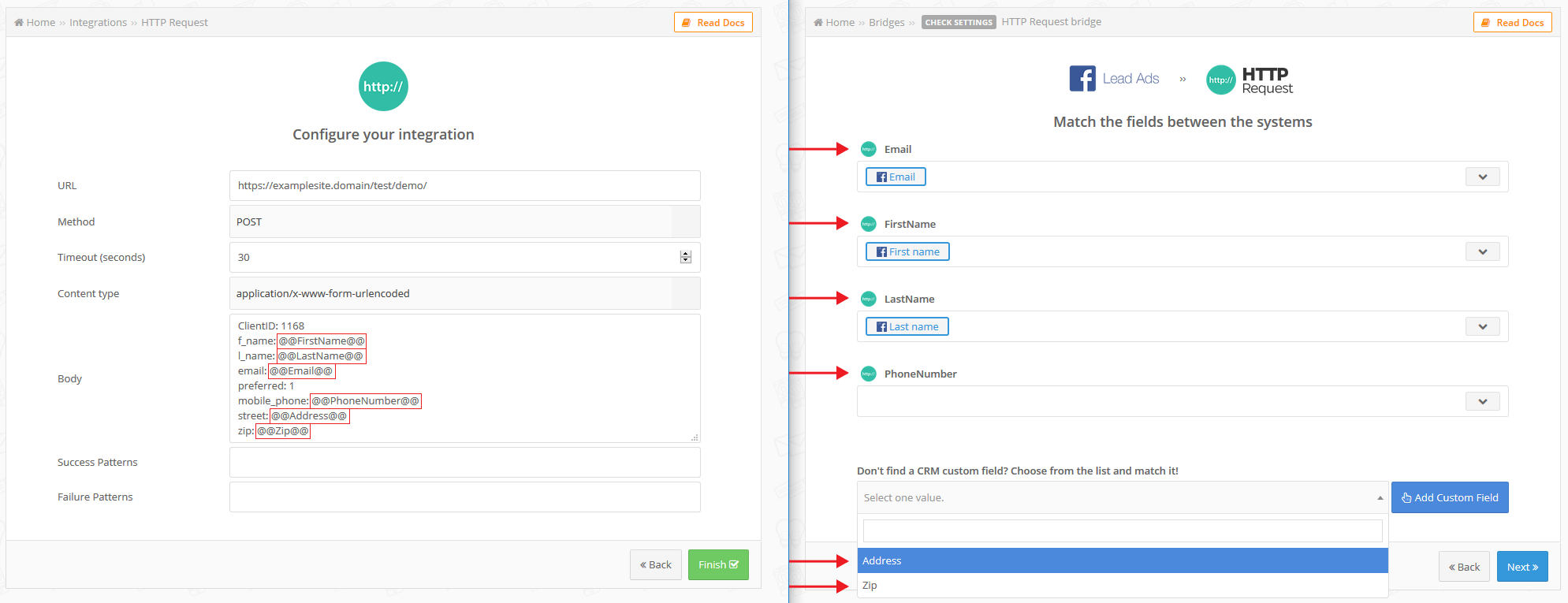

Step 2.E: Email Receipt (Optional)
You may choose to receive an email receipt for each incoming lead.
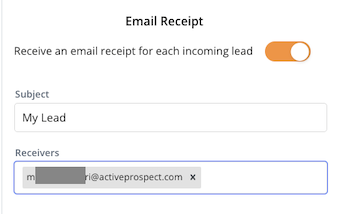

- Type the address(es) where you'd like to receive the receipt
- You may also modify the Subject line of the email
Step 3: Fields Mapping
Here you'll be able to map your Salesforce® Marketing Cloud information with your HTTP Request (GET/POST) fields.
- You will have HTTP Request (GET/POST) fields on the left. Match the information you wish to pass align from Salesforce® Marketing Cloud
- Based on HTTP Request (GET/POST) functionality, some fields might be required; if this is the case, you can identify those fields with a * (star), so be sure to map all them
- You can also use the functions to customize information like reformatting dates and times or modifying text, phone numbers and so on.
- You may leave blank the box of a field's information you don't want to send through. Clicking on the Show unmapped fields button you will have visibility on all the available fields still not mapped
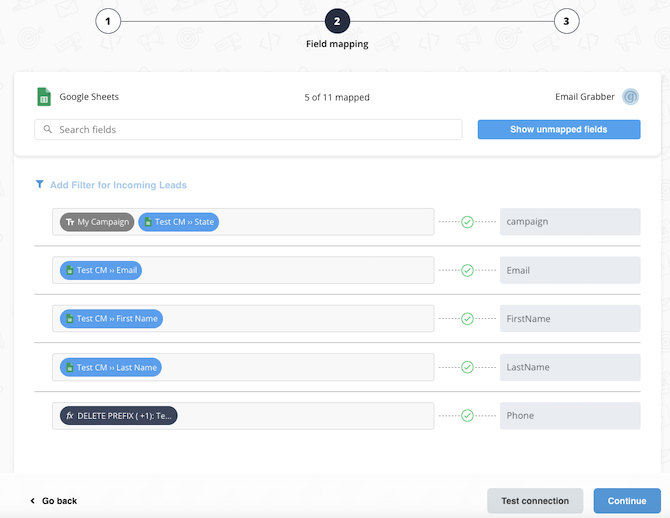

Step 3.A: Leads Filter (Optional)
If you'd like you could add a filter for incoming leads. This filter will sync only leads that meet the configured conditions
- Click on the link Add Filter for Incoming Leads on the top left
- A popup wil be opened where you can configure the filter
- You can define a series of condition to filter the leads. The lead will be synced only when all the conditions will be met
- Once finished, click the Save Changes button to switch back to the Fields Mapping to continue with the bridge configuration
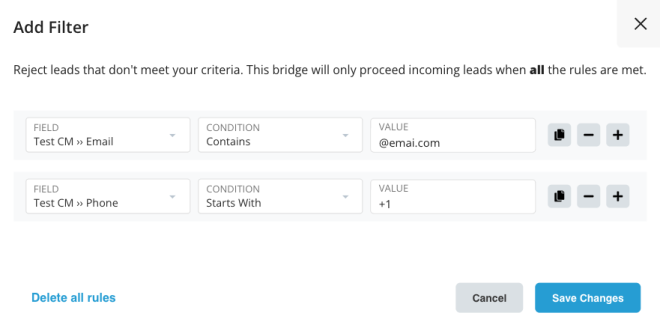

Step 4: Save and Publish
- Click on the Save and publish button
Congratulations! Now your bridge is up and running
Do you need help?
Here some additional resources:
- Salesforce® Marketing Cloud documentation page and common questions
- HTTP Request (GET/POST) documentation page and common questions
- LeadsBridge KNOWLEDGE BASE
- Contact support from your account clicking on the top right Support button


